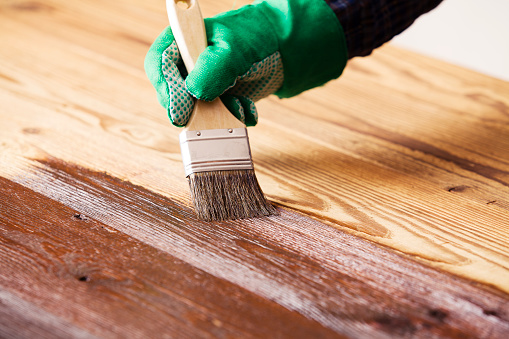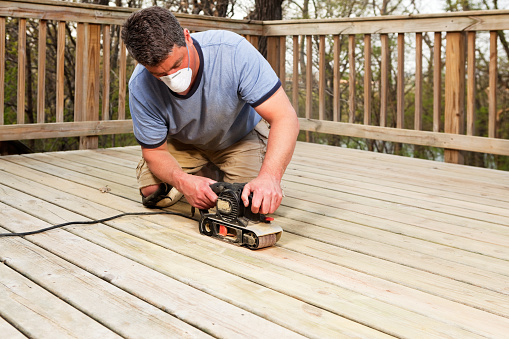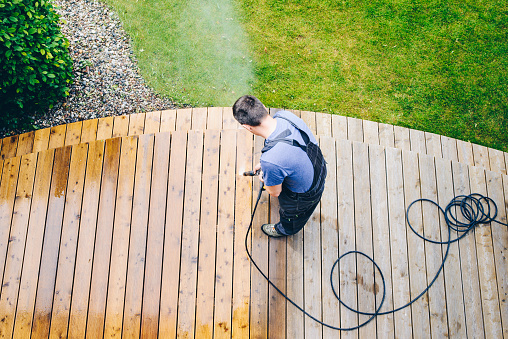Decking can transform the look of any garden, creating a focal point for social gatherings, a raised platform from which to survey your garden, or even just a nice place to relax and enjoy the peace and quiet. The downside to decking is that it needs proper maintenance or it will soon start to degrade. Exposure to the unpredictable weather conditions of the UK can cause your decking to become discoloured, warped, decayed, and damaged if it isn’t properly cared for.
So what is the best way to do that?
To be honest, there isn’t a one stop fix for all maintenance that needs to be done, and there are factors that come into play when choosing the right course of action. For example: is the decking new or old? Are just wanting to preserve the original condition, or rejuvenate some old and tired looking decking? Maybe you just want to deal with some stains that have appeared?
In this article we have tried our best to address decking maintenance from as many angles as possible, so we are confident you will find the advice you’re looking for below.
Problems from unmaintained decking
Not looking after your decking can lead to all sorts of problems. For a start there is the fact that it will start to look old and a bit of an eyesore as colour fades and coatings start to peel. On top of that, there are safety issues. A buildup of algae and moss on the boards can lead to the surface being extremely slippery and that’s an accident waiting to happen.

Eventually, if left at the mercy of the elements, your decking will become to rot away and deteriorate completely, leaving you no choice but to dump it or replace it.
When to maintain decking
You should ideally do your maintenance twice a year, in the Spring and Autumn. This will give your decking a new defensive barrier to deal with the more extreme weather changes that follow in Summer and Winter. If your decking is looking particularly downtrodden and worn, there’s no need to wait until Spring or Autumn, just make sure that they’ll be a spell of dry weather and do your maintenance then
How to maintain decking: new decking
If you’ve just purchased new decking, it should already be pressure treated with a preservative to prevent rot and fight off insects and mould, but check to make sure before doing anything else. Once you’ve confirmed that the decking is treated, you should just leave it as it is for 4-6 months. This will allow time for the original treatment to wear off, and then you can go about re-treating it yourself.
On the other hand, if the decking arrives untreated, you need to get busy protecting it with decking treatment.
How to maintain decking: Protecting your decking
Whether it arrived treated or not, any deck that is over 6 months old is going to need protection from the elements.
When it comes to protecting decking, you are not short of choices. There are so many products to choose from, but they basically all fit into one of four categories:
Best decking stains
One of the most popular methods of maintaining decking is to use staining products. Not only will they provide protection from the harsh weather we experience in winter, but they also alter the colour of your decking.
Best furniture and decking stain for woodwork
This is great for giving faded old boards a new lease of life, and with a variety of different colours to choose from, you can find something that suits your tastes, and looks good with your garden furniture and features.
Oils
Like staining products, oils can also change the colour of your decking, usually to a darker shade but not always. Oils will soak into your wooden planks and there they will mix with naturally occurring oils, protecting your decking from the inside. Oils will provide surface protection too but generally not to the extent of staining products. Or at least that’s my experience with them anyway.
Sealers
Personally, I’m not a great fan of sealers. It’s not that they don’t work, because they do work really well.
It’s just that they don’t really make your wood look that great, and more than that; all but one such product that I’ve used as started to flake and eventually peel off after a while. The worst thing is, you have to remove the remaining sealer before applying a new coat, so it just doesn’t seem worth it to me.
having said that, my brother uses a specific brand that I just can’t remember the name of off the top of my head, and he swears by it, so maybe I just had bad luck with them.
Protectors
If you want to keep the original appearance and colour of your boards, then these products are best for you. On top of that, they offer a good level of protection from moisture and other types of damage. Decking protectors soak into your decking boards leaving no trace behind. Before applying your chosen protection, you need to give it a good cleaning, and the fastest way to do this, is to use a pressure washer.
Best deck cleaner
Shifting dirt, grime, algae, and moss, will be so much easier with a pressure washer ( I use my trusty petrol pressure washer for this), but if you don’t mind a bit of graft, feel free to save yourself a few quid and do it the old fashion way with a broom and brush and a deck cleaner. Choosing the right time to clean and treat your decking is very important, and you want to keep an eye on the weather forecast and choose a good few days of sunshine with little chance of rain. This will allow your decking to dry out after cleaning and also give you good conditions to apply your treatment.
Decking Cleaning & Accessories
Although it might be tempting to use a sprayer to apply your treatment, I would recommend going old school and using a soft haired brush to apply it instead. In addition to this, I would also advise not going over the top with the number of coats you put down. The wood can only absorb a certain amount and then you are just wasting product and also leaving an unnecessary layer on top of the boards.
How to maintain decking: restoring old boards
If your deck has seen its fair share of years pass by, it’s probably a good idea to restore them; and there are a couple of options available. The first, and most common, way to deal with the restoration is to use a specially designed decking restoring product. The second way involves sanding the boards down.
Here’s how to do both:
Using a decking restorer
Once you decide on a product and buy it, you then need to clean off any algae, mould, and dirt, from the boards. This can be done by scrubbing, or by using a pressure washer. Next, take some white spirit and use it to remove any remaining traces of the previous stain, oil, etc. from the decking. This is important in order to get the most out of the restorer.

With this done, you just need to grab a brush and your restring product and apply it to the decking. It is a good idea to get down and scrub the restorer into the board with a wire or hard bristled brush after application too.
Leave everything to dry out for 3-4 ours before cleaning the area using your hose pipe.
When everything has dried off, you’ll need to add a treatment like the four we outlined above. i.e. Stain, oil, sealer, or protector
Sanding the boards

For this you’ll need an orbital sander and two different types of sandpaper; one rougher than the other. For most decking, 40-60 sandpaper and 80-120 paper will be just fine. Clean off your decking as with all the other methods on this page, and then start with the rougher sandpaper. Sand away the top over-weathered layer, and then switch the less harsh sandpaper to give it the finishing touches. Grab your vacuum cleaner and get rid of all the dust, then treat the boards with your choice of protection from earlier in this article.
Of course, you can always just paint over the decking to give it the appearance of being younger, but I suggest only doing this if you use paint that has been specifically designed to be used on decking or you’ll soon find yourself staring at a flakey looking decking area.
